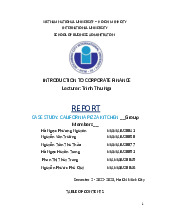




Preview text:
lOMoAR cPSD| 36490632 CORPORATE FINANCE
Chapter 15: Long-Term Financing I.
Some Features of Common and Preferred Stock:
➢ Features of Common Stock
● Voting rights (Cumulative vs. Straight)
- Cumulative voting: protect minority investor
- Straight voting: protect big investor ● Proxy voting ● Classes of stock ● Other rights
- Share proportionally in declared dividends
- Share proportionally in remaining assets during liquidation
- Preemptive right – first shot at new stock issue to maintain proportional ownership if desired
➢ Features of Preferred Stock ● Dividends
- Stated dividend must be paid before dividends can be paid to common stockholders.
- Dividends are not a liability of the firm, and preferred dividends can be deferred indefinitely.
- Most preferred dividends are cumulative – any missed preferred dividends have to
be paid before common dividends can be paid.
● Preferred stock generally does not carry voting rights. lOMoAR cPSD| 36490632 II.
Corporate Long-Term Debt:
➢ Debt versus Equity □ Debt □ Equity ■ Not an ownership interest ■ Ownership interest
■ Creditors do not have voting rights ■ Common stockholders vote Interest is considered a cost
for the board of directors and
■ of doing business and is tax other issues deductible
■ Dividends are not considered a cost of doing business and Creditors have legal recourse are not tax deductible ■ if interest or principal Dividends are not a liability payments are missed Excess of the firm, and stockholders debt can lead to financial ■ have no legal recourse if distress and bankruptcy dividends are not paid An all-equity firm cannot go ■ ■ bankrupt III.
Some Different Types of Bonds:
➢ The Bond Indenture:
● Contract between the company and the bondholders that includes: - The basic terms of the bonds -
The total amount of bonds issued -
A description of property used as security, if applicable -
Sinking fund provisions: protect bondholders -
Call provisions: protect issuers - Details of protective
covenants ➢ Bond Classifications:
● Registered vs. Bearer Forms ● Security lOMoAR cPSD| 36490632
- Collateral – secured by financial securities
- Mortgage – secured by real property, normally land or buildings - Debentures – unsecured
- Notes – unsecured debt with original maturity less than 10 years ●
Seniority ➢ Required Yields:
● The coupon rate depends on the risk characteristics of the bond when issued.
● Which bonds will have the higher coupon, all else equal?
- Secured debt versus a debenture
Debenture: secured debt is less risky because the income from the security is used to pay it off first
- Subordinated debenture versus senior debt
- Subordinated debenture: will be paid after the senior debt
- A bond with a sinking fund versus one without
Bond without sinking fund: company has to come up with substantial cash at
maturity to retire debt, and this is riskier than systematic retirement of debt through time.
- A callable bond versus a non-callable bond
Callable – bondholders bear the risk of the bond being called early, usually
when rates are lower. They don’t receive all of the expected coupons,
and they have to reinvest at lower rates. ➢ Zero Coupon Bonds
- Make no periodic interest payments (coupon rate = 0%)
- The entire yield to maturity comes from the difference between the
purchase price and the par value
- Cannot sell for more than par value
- Sometimes called zeroes, deep discount bonds, or original issue discount bonds (OIDs) lOMoAR cPSD| 36490632
- Treasury Bills and principal-only Treasury strips are good examples of zeroes
➢Pure Discount Bonds
- Information needed for valuing pure discount bonds:
- Time to maturity (T) = Maturity date - today’s date - Face value (F) - Discount rate (r)
- Present value of a pure bond at time 0:
PV = F/(1 + r) T ➢ Floating Rate Bonds
- Coupon rate floats depending on some index value
- Examples – adjustable rate mortgages and inflation-linked Treasuries
- There is less price risk with floating rate bonds.
▪ The coupon floats, so it is less likely to differ substantially from the yield to maturity.
- Coupons may have a “collar” – the rate cannot go above a specified
“ceiling” or below a specified “floor.” ➢ Other Bond Types
- Income bonds – coupon payments depend on level of corporate
income. If earnings are not enough to cover the interest payment, it is
not owed. Higher required return
- Convertible bonds – bonds can be converted into shares of common
stock at the bondholders discretion Lower required return
- Put bond – bondholder can force the company to buy the bond back
prior to maturity Lower required return lOMoAR cPSD| 36490632
- There are many other types of provisions that can be added to a bond,
and many bonds have several provisions – it is important to recognize
how these provisions affect required returns. IV. Bank Loans: ● Lines of Credit
- Provide a maximum amount the bank is willing to lend
- If guaranteed, referred to as a revolving line of credit ● Syndicated Loan
- Large money-center banks frequently have more demand for loans than they have supply.
- Small regional banks are often in the opposite situation.
- As a result, a lager money center bank may arrange a loan with a firm or
country and then sell portions of the loan to a syndicate of other banks.
- A syndicated loan may be publicly traded. V. International Bonds: -
Eurobonds: bonds denominated in a particular currency and issued
simultaneously in the bond markets of several countries -
Foreign bonds: bonds issued in another nation’s capital market by a foreign borrower



